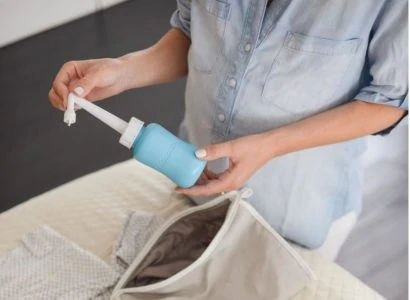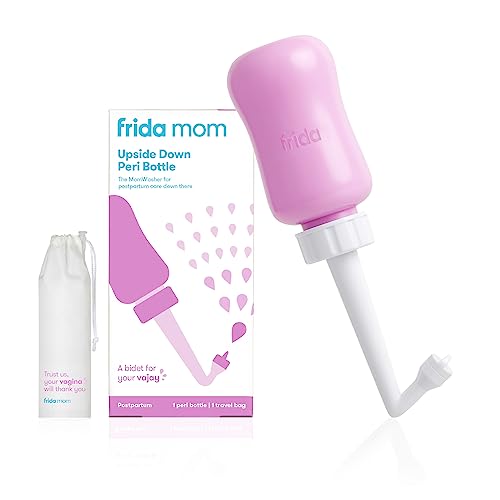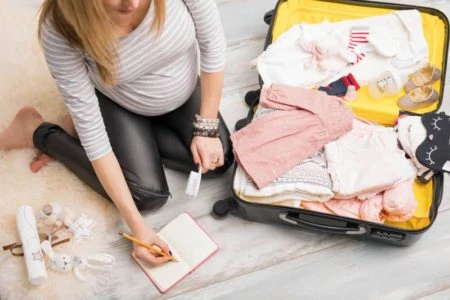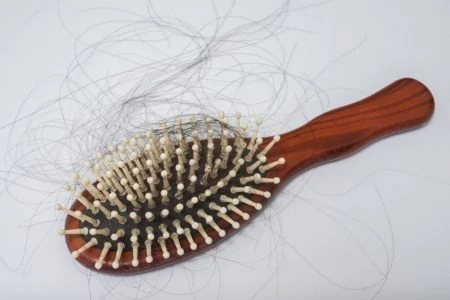When you’re packing all those cute baby items for the hospital, a peri bottle might not even be on your radar. After all, the hospital usually provides one, right?
Let me assure you, although the hospital peri bottle will work OK, it’s not the only design on the market or the best. Our team of moms has experienced childbirth many times amongst us, and we’ve searched for the best peri bottles to make the experience as clean, safe, and convenient as possible.
We’ve reviewed these top three peri bottles based on how easy they are to use and clean, how portable they are, and how much water they can hold for the best and gentlest perineum cleaning experience.
- BPA- and phthalate free
- Long spout for easy targeting
- 15-ounce capacity
What’s the Perineum?
If you don’t know what the “perineal” stands for in perineal irrigation bottle, don’t be embarrassed. I had no idea what the perineum was before I had a baby and found out the hard way.
The perineum, or your perineal area, is the diamond-shaped soft tissue that runs from your urethra around your vagina and back to your anal canal. It’s critical to maintaining the structure of the pelvic floor, which keeps gravity from pulling on some of our reproductive and urinary organs.
If you’re a visual learner, check out this cool video to learn more about the female anatomy.
Childbirth and the Perineum
Childbirth is usually divided into three different stages: the labor stage (divided into latent, active labor, and transition), the delivery of the infant, and the passage of the placenta. During the second phase, while the baby crowns, your perineum may tear.
By the end of your first stage of labor, your cervix should be about ten centimeters wide, and you’ll probably feel the urge to push. Your body is telling you that it’s time to deliver this baby!
As you start to push, your baby will move into your vagina and begin to “crown” — exiting your body head first (hopefully!) into the world. Although babies are small, your perineal area will still need to stretch significantly to allow your baby’s body to pass through. This is what the perineum is made to do.
Sometimes, especially if this is your first labor or your baby is bigger than average, the perineum can tear naturally during childbirth. Other times, if your baby is struggling to make it through the birth canal, the doctor can perform an episiotomy — an intentional incision in the perineum, to ensure delivery continues to progress safely (1). Surprisingly, it’s better to tear than to be cut, as it’s easier for the perineum to heal naturally after tearing.
This sounds painful, and it is. However, woman to woman, some form of perineal tearing happens to most of us during childbirth, so it’s probably something you should prepare for.
How a Peri Bottle Can Help
Even if your perineum doesn’t tear during childbirth, it will still be sore and swollen for a few days after delivery. If you did have some tearing or lacerations, it could be painful for several weeks.
Regardless of the degree of tear or its location, the most important thing you can do to recover quickly is to regularly clean and soothe the perineal area. This will ward off any infections and will also help to make it as comfortable as possible when going to the bathroom. Often the nursing staff at your hospital will give you a basic peri bottle after your child’s birth and show you how to use it.
A peri bottle is one of the easiest and most convenient ways to regularly clean the perineal area. They are small and super easy to use. This makes them perfect for throwing in your purse once you feel like getting out of the house — helping you avoid discomfort when using the bathroom in public.
To use a peri bottle, follow these steps:
- Wash your hands to ensure they are germ-free when in contact with the area.
- Fill the peri bottle with warm water. You may also use cool water for soothing if that feels better for you.
- Remove any peri-padding you may be using to absorb vaginal discharge after birth.
- Squeeze the peri bottle to spray the area with water, moving from front to back.
- Gently use toilet paper or cotton wipes to pat the area dry from front to back.
- Get back to cuddling your precious new baby!
It may sound strange, but trust me, my peri bottle became like my new best friend after childbirth. I used it for weeks and couldn’t believe how good that warm water felt.
Product Reviews
Here are 3 great peri bottles to consider.
Frida Mom Fridet Mom Washer
Best All-Around Peri Bottle
This peri bottle was designed to make cleaning as easy as possible. Its biggest advantage is the angled neck, which uses hydraulics to ensure a steady flow of water to the area. The neck is also designed to be narrow, making it easier to navigate.
If this is your second child, you could be on the go sooner than you were with your first baby. Your older one still needs to be cared for and loved, which means you may be healing while staying fairly active. This peri bottle comes with a carrying bag to keep it clean and sterile in your diaper bag.
To use the peri bottle, fill up the reservoir with warm water — it can hold up to 10 fluid ounces. Screw the top back on, keeping one finger over the silver valve. Turn it upside down, point it at the area you need to clean, and remove your finger from the valve.
The manufacturer offers a lifetime warranty for anyone who isn’t happy with the product.
Pros
- One-way air valve to avoid any air bubbles that could break the continuous flow.
- Smaller size for portability.
- Retractable neck for easy carrying.
Cons
- Some moms say it leaks after use.
- It doesn’t hold as much water as some other bottles.
Our Ratings
Ninja Mama Postpartum Peri Bottle
Best Large Capacity Peri Bottle
With the Ninja Mama Postpartum Peri Bottle, you can go longer between refills. It has a 15-ounce capacity, so you don’t need to refill it every time you go to the bathroom. Rest and relax, knowing there’s a large enough capacity to see you through for longer.
The seven-inch spout helps you target the affected area much easier. No more awkward maneuvering to get into the right position.
We love that this bottle is super portable and even discreet. You can take it with you anywhere, and no one will bat an eyelid.
The long spout is retractable, leaving the total height of the bottle only eight inches. It looks like any other water bottle, so you can keep it in your backpack or purse and take it with you to work, a friend’s house, or out shopping.
Pros
- BPA- and phthalate-free.
- Long spout for easy targeting.
- The retractable spout makes the bottle compact and discreet.
- 15-ounce capacity.
Cons
- Water pressure could be better.
- Leaks while traveling, so it needs to stay empty.
Our Ratings
Perineal Irrigation Cleansing Pack
Most Affordable Peri Bottle
For moms who don’t need anything fancy but just want to get the job done, these peri bottles are simple and effective. They come in a pack of three and are similar to the standard issue bottles you may get from your hospital. They work really well.
These bottles hold eight fluid ounces of water when full. To use, simply fill one with water and screw the top back on. Place the bottle directly below the area you want to clean and squeeze. The top is adjustable to allow for different pressures of water flow.
To clean, unscrew the top. Most standard-sized bottle brushes will fit through the opening. This ensures that you scrub hard-to-reach areas.
You may also soak it in soapy water to clean it. Because you’ll have extra bottles, you’ll have the time to do that.
These bottles also come with a plastic carrying bag for portability. Because you get three at a time, you can keep one in different areas of the house so you don’t get caught without one.
Pros
- Easy to clean.
- Simple design for easy use.
- Multiple spray streams mean you can clean more quickly.
Cons
- Some moms noted the material didn’t seem very durable.
- Neckless design can make it difficult to navigate the perineal area.















